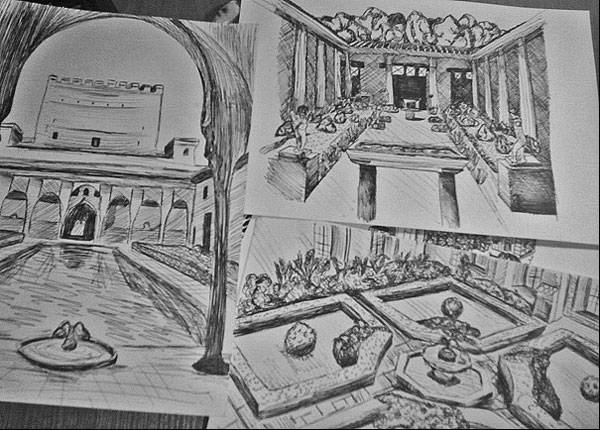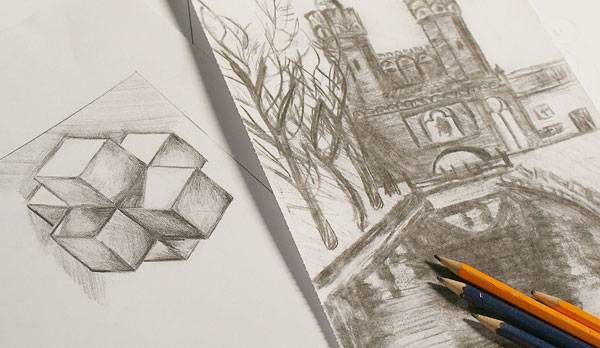We take a look at the importance of drawing and the influence it has on the world of design. Drawing is one of those things that is with us from the earliest stages of our lives. It has always been the best way to entertain kids and it has always been the ultimate time killer in a boring class. It’s been there with us in our everyday lives, from scribbles at the margins of our notebooks to the creation of a realistic rendering. As landscape architects, we sometimes have to draw a little. OK, not “a little”. A LOT. From perspectives to panoramas to planting beds, we’ve drawn them all at some point (and if not, it will happen soon enough, trust me). It doesn’t really matter if you’re working on a new design for your client, drawing for an assignment in your college, or creating something simply for pleasure — drawing truly plays an important (perhaps the most important) role in landscape architecture. Without the drawing, we may not have been able to express our ideas. Without the drawing, our designs would never have been made a reality.
The More We Think, the Less We Know
Drawing helps us to explore the fundamental nature of architectural and natural features. Through drawing, we develop the skill to see the world in a more complex way — a way that allows us to determine the spatial functions of things. As a landscape architecture student myself, I have made countless sketches of various things, from still nature to a busy city street. I have made loads and loads of drawings, all just to realize that the more I’ve sketched, the less I know. Recommended Reading:
- Drawing Scenery: Landscapes and Seascapes by Jack Hamm
- Drawing Nature for the Absolute Beginner: A Clear & Easy Guide to Drawing Landscapes & Nature (Art for the Absolute Beginner) by Mark Willenbrink
Suddenly, the simplest objects become difficult to draw, the easiest outline impossible to sketch. All because as soon as I took a pencil into my hand, I started to analyze everything I wanted to draw. And the more I analyzed, the more questions I had.
Forgetting What We Know
When drawing, we quickly realize that everything we know about the world is of no use to us. As it turns out, what we know and what we see are two completely different, unrelated things when it comes to drawing. Mostly, we are drawing just the optical illusions of things rather than their actual sizes or even shapes. Drawing is not as easy as it may seem at the beginning. As much as it can be a useful skill to have, it can also be a real struggle. If we don’t separate what our minds tell us from what our eyes actually see, we will never be able to get our drawings right. You may not believe me at first, but just think about the last time you were sketching something. Think about the orientation and location of the things you were drawing. One of them was closer to you, another further away, yet another partly covered by something else. In this situation, it is impossible to draw the objects as they are in their “natural” state. For example, an octagonal box the size of a shoebox will seem to us not only to be a cube, but also seem to be bigger than a chair in the distance, which in fact may look like a flat object. See These Other Drawing Related Articles:
- Top 10 YouTube Tutorials for Technical Drawing
- 10 Reasons Why You Still Suck at Drawing
- 5 Ways to Avoid Technical Drawing Becoming Your Worst Nightmare

Drawing and photo by Joanna Łaska
Separating the Mind From the Eyes
We suddenly become aware of the fact that what we KNOW and what we SEE do not always have to go together. That means that our minds can play tricks on us, simply by telling us to draw something more from memory and less from what is really before us. The human brain codes the logical aspects of things — their actual sizes, shapes, cubature, literally everything. From an early age, we learn that some things are bigger or smaller than others. For example, a tree will always be bigger than a shrub. And that means that when drawing a park lane, for example, our minds might suggest that some things are bigger than they actually are, just because we’ve been coding these things all of our lives.

Drawing and photo by Joanna Łaska
Becoming Fully Aware
First, you need to carefully analyze what exactly you are drawing. You need to analyze the overall shape and size, and the structure of the composition. Then, you need to analyze the light and shade — their sources and intensity, how they affect the texture and visibility of the objects in your composition. You will suddenly become aware of all of the factors that influence not only your drawing, but your perception of the world. You will become aware of the materials things are made of, their position and importance in your surroundings. You will simply start to analyze everything you see and how all of these things influence each other. When drawing, you will become aware of the bigger depth of things, how they function, and what are they made of. You will become more sensitive to all of these factors, in your everyday life and also in your sketch works. When we are drawing, we instinctively study the object of our sketching. We analyze the shape, size, color, position, and even texture. We analyze them bit by bit, just to find out how many questions we can ask ourselves about what we’re actually drawing. Drawing makes us ponder a little about the nature of things — what are they made of, why they are there, how do they function.
WATCH: Why We Should Draw More (and Photograph Less)
The Changing Art
The art of drawing is constantly changing. We are constantly presented with new materials and techniques. And it adheres to the contemporary visual environment. When sketching, we are trying to adapt to the modern trends — the lines become more definite, sharper, as if to reflect that print-like style we are all so accustomed to. But even though the style of our drawings is always varied, our perception of the world stays the same. When we draw, we develop a unique approach to the composition and the line itself. We suddenly become aware of the fact that everything that surrounds us can be broken down into lines, intersecting at varied angles, at varied points. We realize how important a role the line actually has in our lives, and our perception of individual objects. So we start to pay more attention to the thickness of the line, as its sharpness may strongly affect our drawing.

Drawing and photo by Joanna Łaska
- Drawing Scenery: Landscapes and Seascapes by Jack Hamm
- Drawing Nature for the Absolute Beginner: A Clear & Easy Guide to Drawing Landscapes & Nature (Art for the Absolute Beginner) by Mark Willenbrink
Article by Joanna Łaska Return to Homepage
Published in Blog






